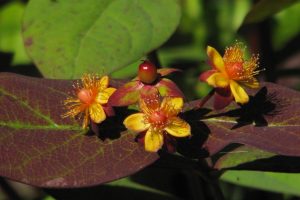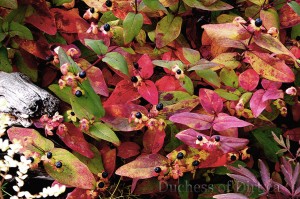|
 Description: An evergreen sub-shrub with an upright, clump-forming habit. Ovate, 4 inch (10 cm) long, green leaves are flushed with purple. Bright yellow, 5-petalled, star-shaped flowers appear in summer. Round, black berries follow. Description: An evergreen sub-shrub with an upright, clump-forming habit. Ovate, 4 inch (10 cm) long, green leaves are flushed with purple. Bright yellow, 5-petalled, star-shaped flowers appear in summer. Round, black berries follow.
Special Notes: Native to western and southwestern Europe, the Mediterranean and Caucasus. Good cut flowers. Leaves are resin-scented when bruised. Fall foliage colour adds wonderful impact to the garden. Watch for rust and leaf spot. Propagate by seed; division in spring or autumn.
 Caution: Best to prune shrub before the black berries drop. Can self-seed somewhat enthusiastically. However, unwanted seedlings are easily pulled out. Invasive weed in New Zealand and Australia. Caution: Best to prune shrub before the black berries drop. Can self-seed somewhat enthusiastically. However, unwanted seedlings are easily pulled out. Invasive weed in New Zealand and Australia.
Posted on October 19, 2012; Updated on March 12, 2022
|